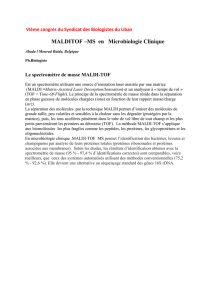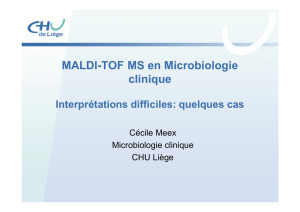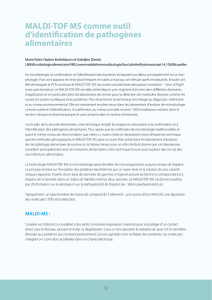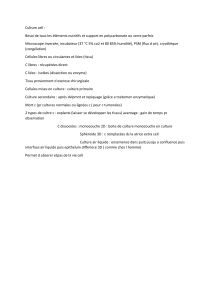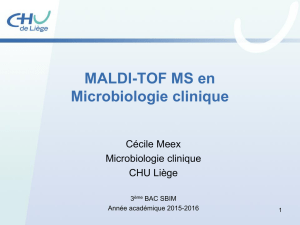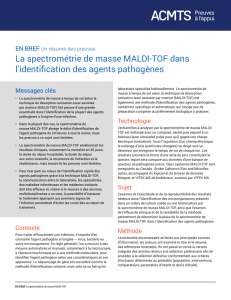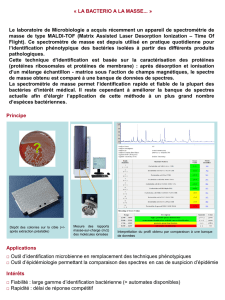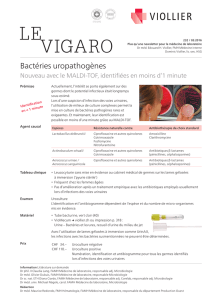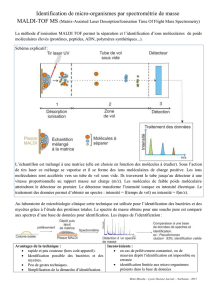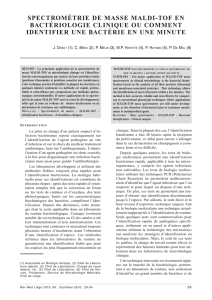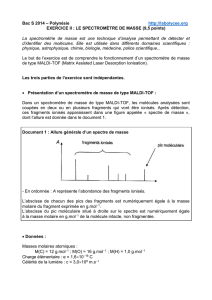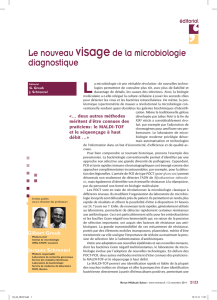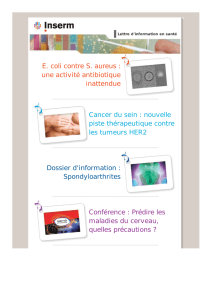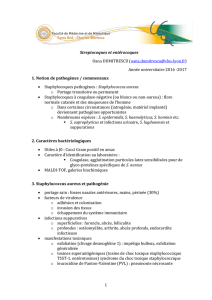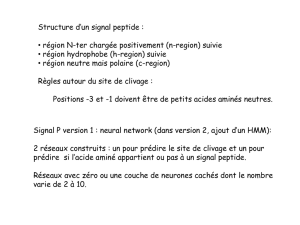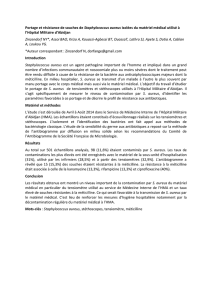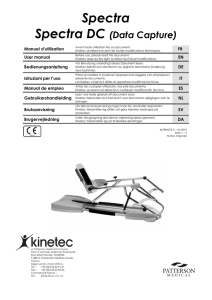Apports de la spectromètrie de masse en pathologie
publicité
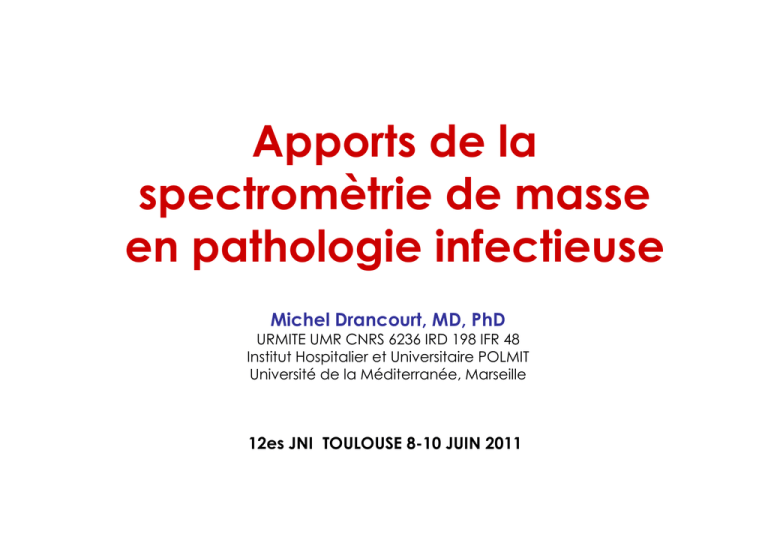
Apports de la spectromètrie de masse en pathologie infectieuse Michel Drancourt, MD, PhD URMITE UMR CNRS 6236 IRD 198 IFR 48 Institut Hospitalier et Universitaire POLMIT Université de la Méditerranée, Marseille 12es JNI TOULOUSE 8-10 JUIN 2011 Structure générale d’un spectromètre de masse SOURCE ANALYSEUR Pour volatiliser et ioniser les molécules Il mesure les valeurs du rapport: masse / nb de charge (appelé m/z) DETECTEUR Détection des ions détecteur + - CHU la Timone Laboratoire de Bactériologie et de Virologie Principe de la source MALDI • Etapes d’ionisation M H+ Ionisation CHU la Timone 1- Co-crystallisation de l’échantillon et de la matrice photosensible – 2- Excitation des molécules de matrices par l’impulsion laser – 3- explosion de la matrice et ionisation de la matrice – 4- transfert de charge et ionisation de l’échantillon M Transfert de charge Analyte – Analyte H+ Laboratoire de Bactériologie et de Virologie Le détecteur Signal électrique ions Amplification électronique Principe d’amplification 1- un ion frappe le détecteur et arrache des électrons 2- les électrons arrachés frappent le détecteur et arrachent d’autres électrons, et ainsi de suite 3- l’ensemble des électrons arrachés vont forme un courant électrique CHU la Timone Laboratoire de Bactériologie et de Virologie L’identification des colonies bactériennes et levures Pick-up colony Deposit colony on plate MALDI-TOF plate loading / matrix overlaying MALDI-TOF processing Profil Identification Database Data collection, interpretation and reporting Inactivation des pathogènes NSB3 compatible avec l’analyse MALDI-TOF Bacillus anthracis, spores 80% TFA, 30-min Lasch P, 2008 Autoclaving Castantia E, 2006 Υ-irradiation Krishnamurthy T, 1996 Brucella melitensis Υ-irradiation Krishnamurthy T, 1996 Burkholderia spp. 80% TFA, 30-min Lasch P, 2008 Francisella tularensis Υ-irradiation Krishnamurthy T, 1996 Mycobacterium tuberculosis 95°C, 30-min Saleeb PG, 2011 95°C, 60-min Drancourt M, unpublished 70% ethanol, 10-min Lotz, 2010 Υ-irradiation Krishnamurthy T, 1996 70% ethanol, 60-min Ayyadurai S, 2010 80% TFA, 30-min Lasch P, 2010 ; Lasch, 2008 Yersinia pestis MALDI-TOF • Currently we routinely test any colony: 200 colonies dayly • Time for technician and cost equivalent to that from Gram staining (No reagent) • ID in 98% of cases within 15-30’ • May detect toxins, antibiotics resistance, clones! Crawling outbreak of Corynebacterium pseudodiphtheriticum in CF patients M. tuberculosis H37RV M. tuberculosis H37Rv P2 P2 100 F1 F1 C. Accolens CIP104783T C. Accolens CIP104783T93 C. propinquum CIP103792T G2 N C. propinquum CIP103792T 98 89 N G2 91 M O J1 J1 98 O M B1 B1 F2 C. pseudodiphtheriticum CIP103420T D K2 A2 P1 100 65 C. Pseudodiphtheriticum CIP103420T H G3 A3 E I2 99 B2 E C L 64 H C A3 A4 I2 100 G3 K1 A2 L G1 A4 99 J2 J2 F2 G1 D K2 K1 P1 I1 I1 B2 MALDI-TOF MS 1000 900 800 700 600 500 400 Distance Level rpoB tree 300 200 100 0 Un tiers de siècle d’identification des bactéries par MALDI-TOF-MS 2009 2008 2007 2006 2005 Vagococcus [24] 2003 Non-fermenting gram 1999 2000 2001 2002 1996 1997 1998 Negative bacilli [18, 6] E. coli* Corona plasma Listeria Gram-positive S. aureus Myco- Streptococcus [34] technique Entero[23] [52] [21] [48] [29] Staphylococcus bacterium bacteriaceae Oral anaerobes S. aureus Mycobacterium [7] B. subtilis, E. coli S. aureus [25] [15] [13] [49] [33] Pioneering Haemophilus B. cereus [32] [26, 27] Stretococcus B. cepacia Bacillus [20] F. tularentis Helicobacter papers [51] S. aureus [22] [19] spores [35] [3, 4] S. aureus [31] [37] Clostridium [50] [28] S. aureus* [8] Helicobacter [30] [36] Routine identification Present report 2004 1975 Seminal paper [2] 1996 1975 1997 1998 1999 2000 2001 2002 2003 2004 2005 2006 2007 2008 2009 Limites actuelles de l’identification des bactéries • Streptococcus pneumoniae ≠ Streptococcus mitis •Shigella spp. ≠ Escherichia coli •Inoculum ~ 108 cfu Log (score)-derived MSP dendrogram from Shigella, EHEC, and E. coli using the MALDI-TOF MS-based Biotyper system. The dendrogram was generated with the distance set at Euclidian and linkage set at completion (23). He Y. et al. JCM 2010; 48:3888-92. Identification of Archaea Dridi B, Drancourt M, unpublished data Identification of Archaea Dridi B, Drancourt M, unpublished data Identification of viruses Clin Microbiol Inf 2010, 16:1620-1625 Applications en routine au laboratoire de microbiologie • Identification des bactéries y compris mycobactéries • Identification des levures • Identification des champignons filamenteux • Identification des hémocultures positives Avantages • Simplicité: formation de l’opérateur en 4 heures • Coût < 1€ l’identification • Rapidité < 10 min – plus rapide que le Gram Prospectives médicales • • Mesurer l’impact médical sur la prise en charge des patients Coût - efficacité Prospectives techniques Souches bactériennes • • • • • S. mitis ≠ S. pneumoniae E. coli ≠ Shigella ? Phénotypes de résistance Phénotypage Déminuer inoculum < 106 cfu Fluides biologiques • • Hemocultures mixtes Urocultures Identification of animals cells Identification of human blood cells Figure 2. MALDI-TOF MS spectra of circulating cells. T lymphocytes (A), PMNs (B) and RBCs (C) were isolated from a healthy blood donor. Representative MALDI-TOF MS spectra are shown. Figure 6Dendrogram of 22 eukaryotic cell types. MALDI-TOF MS was performed on 22 cell types with at least 20 spectra per cell type. An averaged spectrum for each cell type was added to the database using the BioTyper software and the dendrogram creation method. Dendrogram of 22 eukaryotic cell types. MALDI-TOF MS was performed on 22 cell types with at least 20 spectra per cell type. An averaged spectrum for each cell type was added to the database using the BioTyper software and the dendrogram creation method. Identification of mammals The dendrogram obtained by the software Maldi Biotyper 2.0 (Bruker Daltonics) after peptide spectral analysis is congruent with the one derived from cytochrome b sequencing by the software Tree View (Free down load from the Internet site: http://darwin.zoology.gla.ac.uk/~rpage/treeviewx/download.html). The images indicate the mammalian species (left) from which the ancient teeth were identified (right). MALDI-TOF MS peptide profiling of proteins extracted from dental pulp. Pseudo-gel displays (Gel View, Bruker Daltonics) of the peptide spectra obtained with wild boar (a) and pig (b) specimens were used as the reference peptide. The mass-tocharge ratio (m/z) of each peptide is indicated on the x-axis, and the relative intensity of each peak is shown on the y-axis. Blue bars correspond to peaks from pig specimens, red bars correspond to peaks from wild boar specimens, and green bars represent peaks shared by both. MALDI-TOF MS peptide spectrum obtained from 8,500-year-old human dental pulp. Conclusion: MALDI-TOF-MS Towards an universal first-line identification approach for living organisms Schematic illustration of application of MALDI‐TOF‐MS on identification of organisms belonging to the 4 domains of life with corresponding references indicated in the brackets (adapted from Boyer M. et al. 2010 PLoS One)
